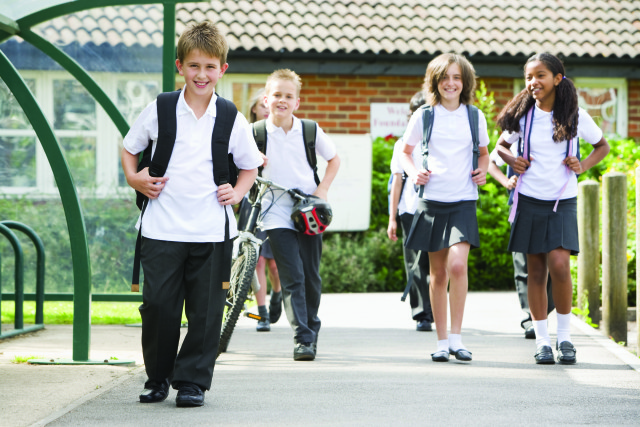School of thought

Karl Walker of Beckhoff explains how changing attitudes towards climate change can help encourage young people to take more responsibility for managing the energy efficiency of their own schools and colleges
We live in a world that has become saturated with technology, keeping us connected and helping us manage every aspect of our lives. We also live in a world that is increasingly looking towards technological advances to help safeguard the future of every living thing on the planet.
So familiar with modern technology have we become that we often forget just how quickly things have changed. The current generation of school children and college students can access information, news and opinion in ways most of us could only dream about just a few short decades ago. And it’s thanks to modern technology, and in particular building controls, that students now have the opportunity to manage the energy performance of their own schools and colleges.
Budget friendly
The continued squeeze on school budgets has resulted in increasing pressure to find cost savings wherever possible. A common view is that the cost of utilities is ring fenced within school budgets, e.g. “that is what it cost last year, therefore we need to budget the same +10% for this year, so savings need to come from elsewhere”.
This needn’t be the case; modern control solutions can deliver savings of between 10-51% in terms of energy consumption. In one recent example; the school’s actual energy consumption was three times higher than the building design estimate. There was no visibility of consumption profiles for the local premises team, and the BMS schedules, setpoints and exceptions had not been configured correctly. To resolve these issues, automated main meter data capture and reporting was integrated, which subsequently allowed energy profiles to be displayed, reviewed and modified accordingly. A systematic approach to energy reduction was also implemented, which enabled the local premises manager to modify schedules and setpoints. The result was a 41% energy saving in less than four months.
But it is not just about reducing the cost of energy. With their futures at stake, students are becoming the most engaged and focused group when it comes to understanding the need for a significant reduction in CO2 emissions. To give them the responsibility of running their building efficiently, some schools are making energy consumption visible to students in easy to understand charts, building layouts and reports, which empowers young people to do what they can to reduce waste.
Room with a view
The latest supervisory control solutions provide a transparent ‘single pane of glass’ view of a building’s systems and a gateway integrates with building control systems and sensors, securely transferring building operation data to a cloud service. By analysing a building’s energy consumption against its control strategy, the BEMS can identify anomalies in a building’s operation, modify as appropriate so that the building operates within its ‘sweet spot’ and maintain the optimised performance level to retain savings.
Building control services, often supplied by different vendors and manufacturers, tend to grow and change over time using a variety of communication interfaces and protocols. These systems are rarely integrated. For example; HVAC, DHWS and lighting controls will generally be independent of each other. Interoperable technology can integrate with existing building controls and securely transfer data to the cloud service using the lightweight MQTT messaging protocol.
At a local level it is possible to utilise numerous communications protocols, including; BACnet, Modbus, M-Bus, DALI and KNX, to provide a supervisory control layer which normalises and centralises services within the BEMS platform. Highly expandable technology also provides the backbone for growth with the option to add more building controls and physical IO.

Climate emergency
Some of the world’s leading scientists have suggested that we are edging ever closer to the point of no return and are set to cross a number of climate tipping points unless we can find a way to significantly reduce our emissions on a global scale. Over the past couple of years, it has become clear that any sort of fightback will be led by a generation of young people that are acutely aware of the very real threat that climate change poses to their future. Inspired by Greta Thunberg and other young activists, words are now consistently backed by actions as carefully coordinated demonstrations and marches help to drive the message home.
In February last year school pupils across the UK staged an organised ‘strike’ in a bid to urge the government to do more to tackle the threat of climate change. But there comes a point where strikes and organised marches are not enough. Perhaps if we give students the trust, responsibility and, crucially, the tools to positively affect the environment they occupy, they will learn the skills to make a big difference in the long term. In some schools, this is already taking effect.
By handing students the responsibility of looking after their school’s energy performance they are gaining valuable life experience at an early age that will prepare them well for their future careers. This is a view shared by Richard Dunne, a former headteacher who founded the Harmony Project in 2018. The Harmony Project recognises the impact of human activity on the natural world, and humankind’s increasing disconnection from nature. Education is one of the sectors in which Richard has applied Harmony and he believes that by rethinking environmental education so that it is at the heart of learning, schools can encourage their students to actively engage with pressing environmental issues at the same time as teaching them valuable life skills.
Richard says: “For the most part, sustainability in education is seen as an add-on. It might be presented as a one-off environmental day or eco week. It will almost certainly be presented outside of the formal curriculum. It may engage the interest of a good many students, but the mere fact that it is not integrated into the broader curriculum means that the opportunities to link learning together are unlikely to be explored.”
He adds: “We need to find ways to bring learning together around purposeful projects and give students a lead role in showcasing the outcomes of their research and the issues they want to address through this process.”
With the technology now available to them, today’s students can play a leading role in managing their own environment at a local level. This may seem like a relatively small step but significantly reducing the carbon footprint of commercial buildings will be an important victory in the ongoing fight against climate change.
https://www.beckhoff.com/







